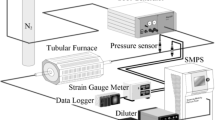Abstract
In current research, aluminium oxide and silicon dioxide are used as raw materials for fabricating main structures of mullite diesel particulate filters. The variable substances applied to develop acicular mullite structure are titanium dioxide, aluminium fluoride, and vanadium oxide. Carbon black was used to create pores in mullite diesel particulate filters with 35 to 45% porosity based on the sintering temperature of 1300°C. The images of the filter’s porous surface microstructure were investigated using scanning electron microscopy. Vanadium oxide and aluminium fluoride play important roles in growth of acicular shape and acicular size for membrane, respectively. Acicular size of membrane varies from a hundred nano-meters to the submicron in needle diameter. The relation of all factors between pore size, porosity, surface roughness, and pin-shape microstructure can be controlled by additional amounts of additives. From Raman spectroscopy analysis, the soot formation of carbon black’s micro and nanostructure are acceptable to simulate diesel soot particles. In line with these results, carbon black was successfully used as a substitute of real engine soot in soot kinetics reactivity. In addition, the oxidation kinetics of soot particles on mullite and acicular mullite membrane were investigated by using tight contact in isothermal and loose contact in non-isothermal thermo-gravimetric analysis. The calculated apparent activation energies of soot oxidation with isothermal technique on mullite and acicular mullite membrane are approximately 213 and 141 kJ/mol while those values calculated with non-isothermal technique are 118 and 76 kJ/mol, respectively.















Similar content being viewed by others
References
Yang J, Stewart M, Maupin G, et.al. (2009) Single wall diesel particulate filter (DPF) filtration efficiency studies using laboratory generated particles. Chem. Eng. Sci. 64(8): 1625- 1634. https://doi.org/10.1016/j.ces.2008.12.011
Mohankumar, S., Senthilkumar, P.: Particulate matter formation and its control methodologies for diesel engine: a comprehensive review. Renew Sustain Energy Rev. 80, 1277–1238 (2017). https://doi.org/10.1016/j.rser.2017.05.133
Burtscher, H.: Physical characterization of particulate emissions from diesel engines: a review. J. Aerosol. Sci. 36(7), 896–932 (2005). https://doi.org/10.1016/j.jaerosci.2004.12.001
Kittelson, D.B.: Engines and Nanoparticles: A Review. J. Aerosol. Sci. 29(5-6), 575–588 (1998). https://doi.org/10.1016/S0021-8502(97)10037-4
Hanamura, K., Karin, P., Cui, L., Rubio, P., Tsuruta, T., Tanaka, T., Suzuki, T.: Micro- and macroscopic visualization of particulate matter trapping and regeneration processes in wall-flow diesel particulate filters. Int. J. Engine Res. 10(5), 305–321 (2009). https://doi.org/10.1243/14680874JER04209
Alder, J.: Ceramic Diesel Particulate Filters. Int. J. Appl. Ceram. Tec. 2(6), 429–439 (2005). https://doi.org/10.1111/j.1744-7402.2005.02044.x
Oki, H., Karin, P., and Hanamura, K.: Visualization of oxidation of soot nanoparticles trapped on a diesel particulate membrane filter. SAE Technical Paper No.2011-01-0602 (2011). https://doi.org/10.4271/2011-01-0602
Sirivaracha, S., Karin, P., Saenkhumvong, E., Chollacoop, N. and Hanamura, K. (2019) Impact of TiO2 and V2O5 on sintered mullite porous microstructure and soot oxidation kinetics using SEM and TGA. SAE Technical Paper No. 2019-01-1407. https://doi.org/10.4271/2019-01-1407
Li, C.G., Pyzik, A.J.: Application of porous acicular mullite for filtration of diesel nano particulates, developments in porous, biological and geopolymer ceramics. Ceramic Eng. Sci. Proc. 28(9), 27–40 (2005). https://doi.org/10.1002/9780470339749.ch3
Zuberi, B., Liu, J.J., Pillai, S.C., et al: Advanced high porosity ceramics honeycomb wall flow filters. SAE Technical Paper No. 2008-01-0623. (2008). https://doi.org/10.4271/2008-01-0623
Schneider, H., Schreuer, J., Hildmann, B.: Structure and properties of mullite – a review. J. Eur. Ceram. 28(2), 329–344 (2008). https://doi.org/10.1016/j.jeurceramsoc.2007.03.017
Cao, J., Dong, X., Li, L., Dong, Y., Hampshire, S.: Recycling of waste fly ash for production of porous mullite ceramic membrane supports with increased porosity. J. Eur. Ceram. 34(13), 3181–3194 (2014). https://doi.org/10.1016/j.jeurceramsoc.2014.04.011
Pyzik, A.J., Todd, C.S., Han, C.: Formation mechanism and microstructure development in acicular mullite ceramics fabricated by controlled decomposition of fluorotopaz. J. Eur. Ceram. 28(2), 383–391 (2008). https://doi.org/10.1016/j.jeurceramsoc.2007.03.021
Karin, P. and Hanamura, K.: Particulate matter trapping and oxidation on catalyst-membrane. SAE Technical Paper No.2010-01-0808. (2010). https://doi.org/10.4271/2010-01-0808
Karin, P., Boonsakda, J., Siricholathum, K., Saenkhumvong, E., Charoenphonphanich, C., Hanamura, K.: Morphology and oxidation kinetics of ci engine’s biodiesel particulate matters on cordierite diesel particualte filters using TGA. Int. J. Automot. Technol. 18(1), 31–40 (2017). https://doi.org/10.1007/s12239-017-0003-y
Neeft, J.P.A., Nijhuis, T.X., Smakman, E., Makkee, M., Moulijn, J.A.: Kinetics of the oxidation of diesel soot. Fuel. 76(12), 1129–1136 (1997). https://doi.org/10.1016/S0016-2361(97)00119-1
Atribak, I., Bueno-Lopez, A., Garcia-Garcia, A.: Uncatalysed and catalysed soot combustion under NOx + O2: real diesel versus model soots. Combust Flame. 157(11), 2086–2094 (2010). https://doi.org/10.1016/j.combustflame.2010.04.018
ASTM C20-00: Standard test methods for apparent porosity, water absorption, apparent specific gravity, and bulk density of burned refractory brick and shapes by boiling water. (2005). https://doi.org/10.1520/C0020-00R10
Fino, D., Bensaid, S., Piumetti, M., Russo, N.: A review on the catalyst combustion of soot in diesel partiulate filters for automotive applications: from powder catalysts to structured reactors. Appl. Catal. A-Gen. 509, 75–96 (2016). https://doi.org/10.1016/j.apcata.2015.10.016
Karin, P., Borhanipour, M., Songsaengchan, Y., Laosuwan, S., Charoenphonphanich, C., Chollacoop, N., Hanamura, K.: Oxidation kinetics on small ci engine’s biodiesel particulate matter. Int. J. Automot. Technol. 16(2), 211–219 (2015). https://doi.org/10.1007/s12239-015-0023-4
Chen, Z., Suchech, S., Faber, K.T.: A Hierarchical study of the mechanical properties of gypsum. J. Mater. Sci. 45, 4444–4453 (2010). https://doi.org/10.1007/s10853-010-4527-z
Karin, P., Cui, L., Rubio, P., Tsuruta, T. and Hanamura, K.: Microscopic visualization of pm trapping and regeneration in micro-structural pores of a DPF wall. SAE Technical Paper No.2009-01-1476. (2009). https://doi.org/10.4271/2009-01-1476
Vyazovkin, S., Wight, C.A.: Isothermal and nonisothermal reaction kinetics in solids: in search of ways toward consensus. J. Phys. Chem. A. 101(44), 8279–8284 (1997). https://doi.org/10.1021/jp971889h
Funding
This work is funded by the Thailand Research Fund, RRi-PHD57I0027.
Author information
Authors and Affiliations
Corresponding author
Ethics declarations
Conflict of Interest
The authors declare no competing interests.
Additional information
Publisher’s Note
Springer Nature remains neutral with regard to jurisdictional claims in published maps and institutional affiliations.
Rights and permissions
About this article
Cite this article
Saenkhumvong, E., Karin, P., Win, S.Z. et al. Influence of V2O5 and AlF3 on Microstructure of Acicular Mullite Diesel Particulate Filter Along with Soot Oxidation Kinetics. Emiss. Control Sci. Technol. 7, 287–301 (2021). https://doi.org/10.1007/s40825-021-00201-6
Received:
Revised:
Accepted:
Published:
Issue Date:
DOI: https://doi.org/10.1007/s40825-021-00201-6




